Film For someone who is super sensitive to spoilers to the point of ignoring trailers, pre-publicity interviews and often chooses whether to watch a film based on the poster, I've become quite addicted to reading reviews of the new Fantastic Four film. I have been very much spoilt but nevertheless hope to see it next week even if it does mean traipsing into an Odeon. This then isn't a review. It's a commentary on the concept of making a Fantastic Four based on watching Rotten Tomatoes like a hawk.
For all I know, the current 9% score is unbelievably harsh and unwarranted but every single review is essentially saying the same things. That a decent cast, trying their best, is working up against a poorly thought through concept based on a misunderstanding of the original comic book then made worse by clear studio interference leading to reshoots that lead a narratively nonsensical chronological time jump into a finale which is poorly set up. That exposition replaces convincing interpersonal relationships and that key characters barely have a conversation.
All of which is terribly weird and sad. Josh Trank the director seems to be under the impression that his own brilliant concept has been destroyed by the studio, but if reports are correct, he'd already fundamentally misunderstood what the characters are about anyway, starting with the cast and working sideways, so there wasn't anything much anyone could do. To an extent I have some sympathy with the studio who were presumably expecting one film, he delivered something else and they've tried to fix it in post.
Trank's idea is sound. But it seems a shame to bend an existing property into something it isn't rather than try something new. Or as seems to be the case, Chronicle again. The reason the MCU has been such a success is that its not embarrassed about these characters as they appear in the comics and embraces them and when it knows its a fairly hard sell it puts that on-screen as per Ant-Man, in which Paul Rudd character voices the audiences's concerns about the ridiculousness of the whole then embraces that ridiculousness, so we do too.
But I don't believe the Fantastic Four is hard. The various versions which have appeared on Saturday morning television all seemed to get their head around the concept of a famous family of superheroes fighting the weird and surreal and even the Tim Story films, for all their weaknesses, got some of that. The Incredibles did too as it shamelessly borrowed the concept and even most of the super powers. Yet Trank, with his "superpowers as disability/body horror" concept simply doesn't.
Here's how you structure a Fantastic Four film:
Prologue: Doom and Richards. In the style of Sneakers. Reed and Victor at the moment during the first science project, shit happens, Doom's scarred. Reed goes on to graduate. Cut to:
Titles.
First half hour: Introduce the characters. About the only change I'd make is having Reed and Sue married already thereby underscoring the concept of family early. As for the rest of it I wouldn't vary the origin too much. Reed's research project is in financial difficulties which is what leads him to ...
First turning point - the experimental test flight. Do the rocket thing. Rockets are exciting.
Second half hour: The four discover their powers and what they can do with them with Ben dealing with his deformity. Leading to ...
Second turning point: They very visibly use their powers for good and I wouldn't go for a conventional disaster. I'd have the Mole Man. I'd have a recreation of the cover of the first issue. The whole media is there so cut to ...
Doom watching the whole business in his castle in Latveria. He's a bit cross about the whole thing.
Third half hour: The fame. All of that business. Basically they're the Ghostbusters so we have a montage sequence in here too of them fighting various foes. In the midst of this we have Doom plotting, plotting. But he doesn't want to take over the world, he already rules his own kingdom. He just wants revenge.
Third turning point: This is where it gets tricky. In the comics he kidnaps Sue which in today's terms is a bit rubbish. Or drops a rocket on the Baxter Building. I suspect it would be more interesting if he kidnaps Reed and it's up to the rest of the team to save him with a geopolitical issue in relation to them invading another sovereign nation.
Fourth half hour:
They go in and save Reed. Huge battle sequences of the Fantastic Four fighting armies, the twist being that they won't hurt anyone. Perhaps, just to cover all the classic 60s bases, Doom's somehow in an alliance with the Skrulls (a previous experiment having attracted their attention) and Reed's been replaced by one of them?
All of which looks predictable and cliched but as I discovered during my film studies degree, people tend to like the repetition of genre films, that it's the variation in formula they like and although you can dump that formula, you have to be very smart about how you do it or you can get it terribly wrong and things can go badly.
Of course the ideal scenario would be for Fox to now do a Sony and lease the right to the F4 back to MARVEL so they can appear in the MCU.
But the problem is, much as they're in the process of re-conceiving the Inhumans to act as their version of the mutants, large chunks of the FF concept have already turned up in The Avengers films, notably the idea of having famous superheroes who're idolised by the populace and who don't really have secret identities.
Not to mention the alien invasion idea which would be perfect with the Skrulls has been done too.
Plus if they can just about get away with not having the whole team turn up in the individual films when the shit hitteth at the end, having a Fantastic Four in the verse not helping Thor fight Loki really begins to stretch credulity.
None of which is to say I wouldn't wish them not to at least try. SHIELD still has its problems but that's heading into a third series.
Since we're taking this to its natural conclusion, some casting suggestions for the MCU Fantastic Four:
Matt Smith is Reed Richards
Kristen Bell is Sue Storm Richards
Zac Efron is Johnny Storm
Woody Harrelson is Ben Grimm
Sam Riley is Victor Von Doom
Sigh. If only.
Updated: If only FOX and Trank and everyone involved with this debacle had been able to watch this first:
The St. George's Hall Floor.
Architecture This morning I attended the formal opening of the floor of St George's Hall by our Lord Mayor Councillor Tony Concepcion, or rather the tape cutting since the wooden covering which usually obscures the Minton tiles for safety and preservation purposes were removed before the event. As the press release describes,
The floor has only recently become a more viewable object, with seven appearance in the past nine years. As local historian Steve Binns explained, when it was initially built the hall was mainly used for court purposes so not seen publically and then when the hall was used for events the floor was closed up pretty quickly.
As such it's not that much different in style to most municipal mosaics or what you might find in a church. The difference is both its scale and also how it appears unfettered by supporting columns, the Hall itself being a great architectural feat and expression at the time construction of Liverpool's national and geographical importance.
In case you want to visit, here are some details:
I've uploaded some photographs of the event and floor to flickr but here are some of the highlights:

I now declare ...
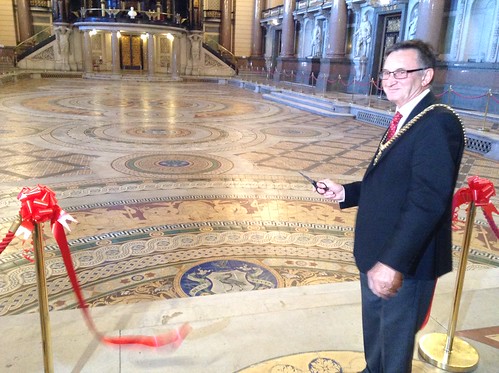
... the St George's Hall floor ...
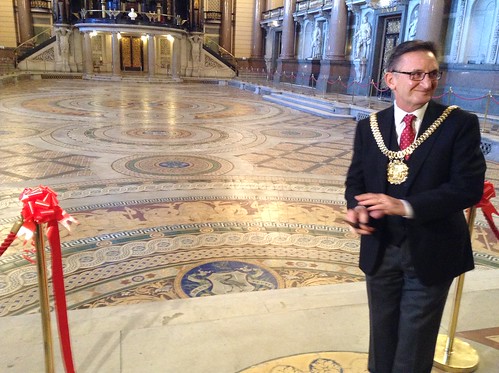
... open ....
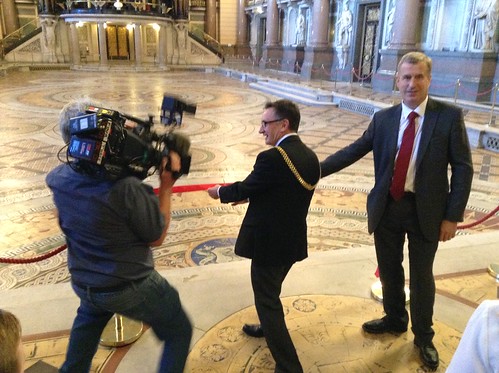
... and again for the cameras.
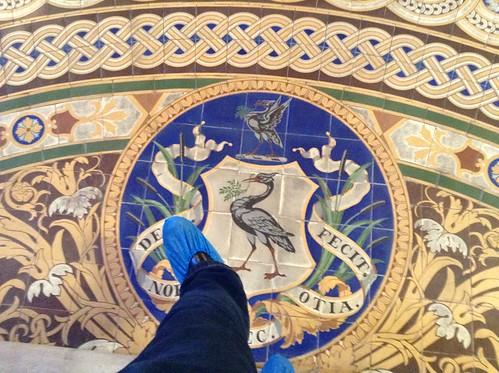
Visitors to the hall to see the floor will be given plastic shoe bags to wear if they want to step onto the floor. Here I am taking my first step.
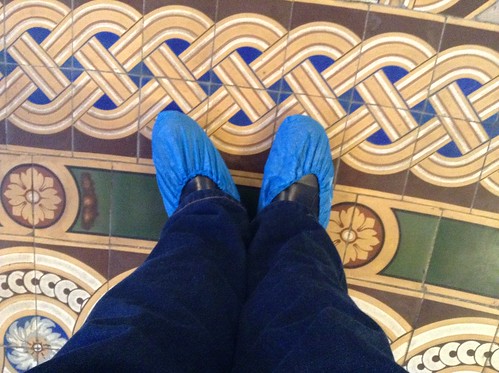
On the floor.
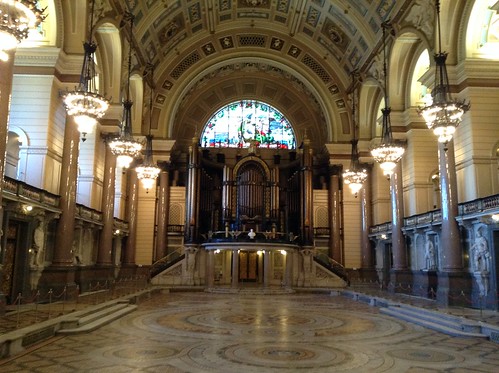
Into the Hall.
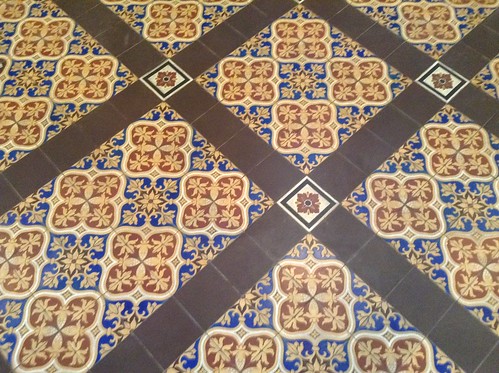
Here's why the wooden cover is important. Find above part of the floor which has just been unveiled.
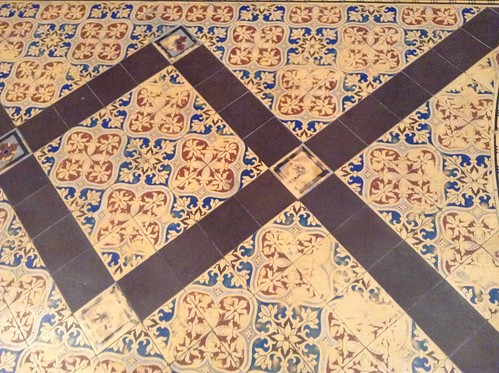
Here's the same pattern on one of the edges where the public is allowed to walk all of the time. The pattern has worn away.
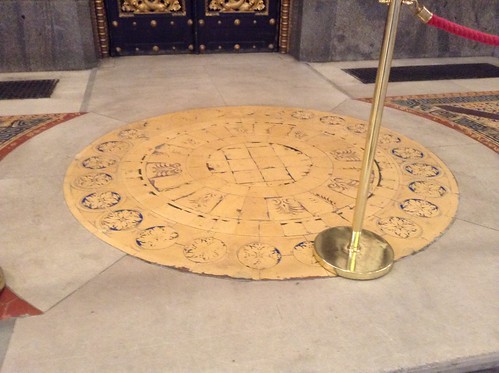
That's especially acute here were the pattern has almost completely gone.

Today of all days I also discovered the panorama option on my iPod and decided to give it a try for the first time whilst standing on the organ platform also for the first time. Click to make bigger.
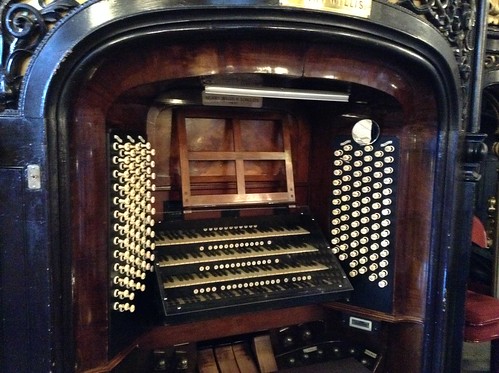
The organ.


Here are a couple more panoramas from standing in the centre of the hall. Sorry about the slight lean. I'm still learning.
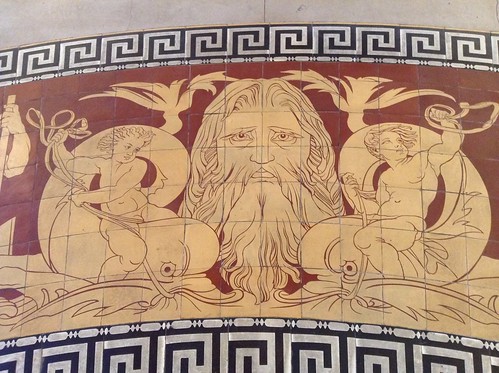

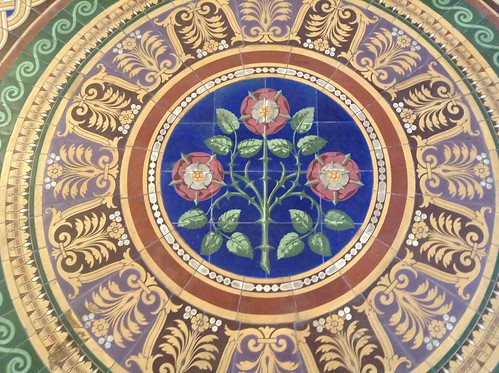
Finally, here are some shots of the floor itself.
"Amongst the world’s finest examples of an encaustic tiled floor, the handcrafted mosaic of more than 30,000 tiles were concealed in the 1860s to allow dancing and events at the prestigious venue. The intricate and exquisite patterned tiled flooring depict the Liver Birds, the Roman god Neptune, sea nymphs, dolphins and tridents in what was the largest Minton pavement in the world when reconstructed."The Hall is used for so many events it's simply impractical to have the floor open all of the time and keep it preserved, which is ironic considering its inherent utility. So for much of the time the only glimpse visitors have is through small windows through the usual wooden cover. There's a decent history of the hall here.
The floor has only recently become a more viewable object, with seven appearance in the past nine years. As local historian Steve Binns explained, when it was initially built the hall was mainly used for court purposes so not seen publically and then when the hall was used for events the floor was closed up pretty quickly.
As such it's not that much different in style to most municipal mosaics or what you might find in a church. The difference is both its scale and also how it appears unfettered by supporting columns, the Hall itself being a great architectural feat and expression at the time construction of Liverpool's national and geographical importance.
In case you want to visit, here are some details:
"The Hall will be open daily to the public from 10am-5pm (last entry 4pm) where visitors will be able to view Liverpool’s hidden gem and gaze again at the site of the Great Hall in all its original grandeur. There will also be Walk the Floor Tours available each day at 10am-11am and 4pm-5pm and A Night on the Tiles; each evening from 6pm-9pm where guests will be able to enjoy the rare privilege of being able to “walk” on the world heritage site floor."The floor is open until the 16th August.
I've uploaded some photographs of the event and floor to flickr but here are some of the highlights:

I now declare ...

... the St George's Hall floor ...

... open ....

... and again for the cameras.

Visitors to the hall to see the floor will be given plastic shoe bags to wear if they want to step onto the floor. Here I am taking my first step.

On the floor.

Into the Hall.

Here's why the wooden cover is important. Find above part of the floor which has just been unveiled.

Here's the same pattern on one of the edges where the public is allowed to walk all of the time. The pattern has worn away.

That's especially acute here were the pattern has almost completely gone.

Today of all days I also discovered the panorama option on my iPod and decided to give it a try for the first time whilst standing on the organ platform also for the first time. Click to make bigger.

The organ.


Here are a couple more panoramas from standing in the centre of the hall. Sorry about the slight lean. I'm still learning.



Finally, here are some shots of the floor itself.
Elastica.
Back of my head in @LivEchonews's photo gallery for the Tate's new Constellations exhibition. http://t.co/QfoWOI7jNy pic.twitter.com/Gh4ChxKHoZ— Stuart Ian Burns (@feelinglistless) August 3, 2015Art For completion sake, here's the back of my head as it appears on the Echo's website in conjunction with the piece about the ... well, see above. That's the Elastica t-shirt I bought at the V96 festival in Warrington which is one of vintage garments I can now fit into again having lost all of the weight due to my hernia operation of a couple of years ago. Look at that line-up and all in one day.
My Favourite Film of 1987.

Film What was the last film you watched more than once? Not just more than once, on a regular basis, because you had to, because you were addicted to it? Now that the availability of material has signalled the death of cinema, I don't tend to watch much of anything more than once. The MARVEL films certainly, at an auditorium then subsequently on the home release. If I've some kind of viewing project on, like #garaiwatch last year which led me to sit through One Day for a second time. But as a friend commented on social media, seeing something again feels like a luxury with so many other options available.
During the commentary for X-Men: Days of Future Past, composer and editor John Ottman laments that for the audience who turned up for the world premiere, their only experience of seeing all the hard work of himself and his colleagues will be at Jacob K. Javits Convention Center in New York with its crappy acoustics and distracting airport nearby, hoping against hope that they'll get the chance to see it in a better environment. He'll be pleased to know I've now seen his film three times, twice in the superior Rogue Cut, albeit with the commentary turned on for two thirds of those. Yes, that would the other reason I might repeat watching a film now.
But there are films which I've seen over and over and over again and most of them are on this list: the Star Wars films (obviously), When Harry Met Sally, All The President's Men, The Last Starfighter, It's a Wonderful Life, the Three Colours trilogy, Starcrossed, In The Bleak Midwinter (most christmases), Love and Other Catastrophes and Citizen Kane. There are others but these are the films which have wracked up at least ten viewings, some of them over twenty, most from the days before you could watch the latest disappointing Simon Pegg vehicle at the click of a button. We'll cover the film you wish you hadn't even watched the once some other time.
Towering above them all is Adventures in Babysitting. I may have seen Adventures in Babysitting over fifty times. For a period in the early 90s, it's the only film I would watch on Saturday night and because I didn't go out much on a Saturday night I spent a lot of time watching Elizabeth Shue take little kids into the city alone. Within a few months I knew the film backwards and forwards and could quote along with the actors, knew where all the music queues would be and eventually the actual film probably became beside the point. Yet we carried on, every Saturday night, Chris Parker, Brad, Straydog, Sara and me.
During my Art A-Level we were encouraged to do as much homework as possible. As we've discussed before I couldn't draw so my main form of expression was in collage and the giant home project I worked on was a paper and paste mosaic of a woman who I knew to be Deanna Troi from Star Trek, though I don't think ever told my teacher that. This consisted of thousands of tiny squares cut from fashion magazines, of black and red from adverts and flesh colour which across the months I painstaking pasted to a piece of card. When I have an image of it to hand I'll add it here so you can see what I mean.
It's during these evenings that I'd watch Adventures in Babysitting too. Now I can't even do monotonous tasks with a film on in the background. Complain about disappointing Simon Pegg vehicles on Twitter perhaps but not tasks. But on those nights I'd be just as absorbed with Bradley Whitford lying about being contagious as making sure all the squares were lined up properly on Deanna's nose or singing along to Babysitting Blues as matching the various reds in her blouse. Eventually I completed the picture and I like to think it was what upped my grade to a B and enough to go to university.
Except I carried on watching. As Hadley Freeman rightly details in her book, some of the socio-economic and racial politics in the film are borderline. But at the age of sixteen I didn't understand any of that. I was too busy seeing myself in Brad with his crush on Chris and indeed having my own crush on her too. My sexual awakening had come much earlier (at around the time of the original release of the film) with Kylie Minogue as Charlene in Neighbours and those dungarees but my eyes didn't leave the 14" portable screen in my bedroom when Shue mimed to The Crystals's Then He Kissed Me, inconsolable when she utilises the bedpost as an imaginary microphone.
For all that, and this seems crucial as Hollywood goes through a process of remembering how to tell stories with female protagonists, I also identified with Chris, even wanted to be her, going on this big adventure in Chicago (not know then that it was largely filmed in Toronto), albeit with the kids in tow. She's smart, ingenious, brave and funny. In an ideal world, Shue would have been able to leverage this performance into a career as a leading actress. Instead she'd spend the next couple of decades playing wives and girlfriends and even though Leaving Las Vegas reminded everyone she could act, it's not until CSI that she'd really become valued.
All of this mostly before I had a decent copy. After renting the film one night and adoring it, I was later in in receipt of a satellite recording which turned out to be a television melon-farmer version with all of the swearing either dubbed over or removed, sometimes with characters reacting to lines which no longer existed, rather like the daytime cuts of Friends which ran on E4 for years. This was later replaced with an ITV broadcast, but that had adverts and the British title of the film, A Night On The Town at the beginning. It wasn't until WH Smiths on Church Street in Liverpool had a sale that I could afford to buy the sell-through release, swearing intact.
Of course the knock on effect of that was I had to learning all the lines over again. Where Darryl had said, "Watch my mouth? You gotta be kiddin’ me" it was now "Watch my mouth? You gotta be shittin’ me" and even now, with the film available on Netflix and owning dvds in two different regions this jars. When Chris says, "Don't fuck with the babysitter!" it sits badly, even though its a more coherent line than "Don't mess with the babysitter!" especially in the context of the train carriage stuck between two warring gangs. But eventually, I was as profane as the characters and in any case when you're the kind of teenager I was, this was all quite liberating.
Watching it again recently on Netflix, giving myself that luxury, I can now see the influence of Scorsese's After Hours, a series of misadventures in the city at night. If only Chris Columbus could scale its heights again, though I have a great affection for his adaptation of Rent, especially the "Light My Candle" sequence. Yet was still impossible for me to watch it as a "film". Even after ten years, even with the freshness of seeing it in high definition in the correct aspect ratio, I could still anticipate every scene, every music cue, every line of dialogue and talked along with it again. Nobody leaves this place without singing the blues.
DLA Piper: Constellations at Tate Liverpool.

Art Sinister computers. Although it would be misleading to say that nothing frightens me, because frankly I'm scared of everything, sinister computers and indeed computers in general would be pretty high on the list along with my own face in the wrong light, biting into biscuits and the future. For a computer to be especially sinister it has to be running but without a particular reason for existence or at least no obvious sense of purpose, even for a limited time. Passing a closed university teaching room filled with computers at night is terrifying, dozens of identical machines with monitor and standby lights flashing in unison. The laptop I'm typing this on is perfect fine right now because it has a working screen, a keyboard and I'm generally master of it, although given that it's a Windows 8.1 machine, "master" tends to be interchangeable with "the things I can get to work". But there are moments, especially when I've closed the lid and my room's dark and the small blue light of the hard disk (pictured) continues flashing when I wonder, "What is it doing? What is it thinking?"
There's a very sinister computer reposing at the new edition of the DLA Piper series Constellations exhibition at Tate Liverpool (for which I attended the press view this afternoon), a Diab DS-101 computer, the exterior for which was designed by the artist Richard Hamilton. Constellations is the semi-permanent display show which fills the first and second floors at Tate Liverpool displaying sections of the gallery's own collection. A particular artwork is explored through a series of pieces by other artists which may be connected either thematically or technically. Elsewhere Louise Bourgeois's wall hanging, Mamelles, which features a three dimensional collage of female breasts in rubber, fibreglass and wood is reflected in a series of piece bringing together ideas of gender and the body including Marcel Duchamp's Female Fig Leaf (the casting of a vagina from another of his mannequins) and Rachel Whiteread's Untitled, one of her customary castings, on this occasion showing the interior of an air bed. The Tate's own website has a better explanation.
The Richard Hamilton constellation is actually "triggered" by a different piece, Towards a definitive statement on the coming trends in menswear and accessories (a) Together let us explore the stars (which as you can see from the image on the Tate's own website) is a collage inspired by JFK's moon speech produced in 1962 at the interstitial point between when the the President said these words and was shot. The rest of the display includes art works which evoke the space age, like Liliane Lijn's kinetic spinning cone Space Displace Koan, with its sleek white surface and lit circular lines which make it seems like the kind of artwork you'd find in the inevitable gallery on the Galaxy-class Starship Enterprise. Artworks about the space race like Pierre Huyghe's video One Million Kingdoms in which an electronic version of Neil Armstrong's voice reads a passage from Jules Verne's Rocket To The Moon computer generating a digital lunar landscape which is explored by a wireframe girl not unlike Rod Lord's animations for the TV version of Hitchhikers. Artworks about the Cold War such as the photographs by Don McCullin of Berlin citizens on either side of the wall.
Then sitting patiently the middle of all that is the Diab DS-101, a short pile of four metal boxes in various shades of grey, the topper most of which has a logo "Diab Data", a cassette drive, a 5.25" floppy drive and another space I can't identity but others have tried. As the accompanying label explains, Hamilton was interested in how the boundaries between art and high end design sometimes merged and was asked by a Swedish computer manufacturer, Dataindustrier AB, in 1983 to design this (what was then) "minicomputer" with a simple three-box design (actually a version of their DS90-3, a UNIX computer with a dual Motorola 68030 processor). So it's a potentially practical object which is also an art object. In the Tate's own image, it looks relatively benign even when you use the little button at the bottom of the photo to rotate it and turn it upside down) and I imagine now that we live in an age when the average microwave has better processing power than this box most people would probably overlook it, or perhaps stop and marvel and how the phone they're using to take its image (since this is an exhibition when such things are allowed) would seem like magic to both the artist and the scientists who designed the innards (though they probably went on to design the phone too).
Except it's actually ghastly, clearly the scariest object the Tate has ever displayed and that includes the faceless infant mannequins in their recent Cathy Wilkes retrospective. I noticed the Diab almost as soon as I entered the exhibition and the fact that it was turned on, the small green and red lights on the front illuminated. There's a cliche about how the eyes on some portraits follow a visitor around the room in stately homes and haunted houses in Scooby-Doo cartoons and these two lights have just that effect, impassive, unchanging and always in my peripheral vision as I wandered the gallery and chatted with friends and even when I couldn't see them, I knew they were there. The reason the Diab DS-101 is sinister is because although it still has utility as an art object, its primary function is obscured and so like the laptop in my room or those university computers at night I can't help wondering what it's thinking. We can find out. There's an array of twenty DVI sockets on the back waiting to output but instead the only form of communication it has is those two lights, one red, one green, both always on somehow, simultaneously reminding us that it exists and is working but also, in my imagination, watching like the circular eye of a HAL-9000.
Which is all, of course, entirely irrational. For a start the processor isn't powerful enough to have artificial intelligence, let alone magically network with the desktop and tablet computer which are surely otherwise in the Tate's ancient building creating a kind of rudimentary Skynet with the potential to overthrow the curatorial direction of the gallery replacing it with some sort of mechanised brain repetitiously scheduling Futurist retrospectives (though it's worth noting - ish - that the WOPR in War Games almost brought nuclear armageddon and that was surely even less powerful than the Diab). Plus there are admittedly far scarier objects in the exhibition, not least the Paul McCarthy video, Painter, a satire on the heroic artist, which is in places so disgustingly scattalogical children aren't allowed to watch it (and here's a shot of me from the Liverpool Echo website doing just that). Yet I am wondering right now if it's turned off when the gallery is closed or is left to sit overnight in the solitary exhibition space plotting our downfall. Perhaps I'd simply be happier if it wasn't turned on at all, if Pinocchio was broken, its strings cut.
DLA Piper: Constellations at Tate Liverpool is free to visit.
"the BBC make-up department in the Doctor Who studios."
TV Recently repeated and so currently in the iPlayer is George Carey's Storyville documentary about KGB agent George Blake who doubled in MI6 sending details of agents to the Soviets during the cold war.
Eventually he was caught and jailed at Wormwood Scrubs but pretty quickly escaped, in October 1966 and was aided in the getaway by two peace activists, Dr Michael Randle and his wife Anne.
Their interview begins about an hour and ten minutes into the piece as they describe how they were contacted by journalists and assumed the police would be on to them pretty quickly. They never were.
During the conversation the following narrative bomb is dropped. My italics for effect:
Eventually he was caught and jailed at Wormwood Scrubs but pretty quickly escaped, in October 1966 and was aided in the getaway by two peace activists, Dr Michael Randle and his wife Anne.
Their interview begins about an hour and ten minutes into the piece as they describe how they were contacted by journalists and assumed the police would be on to them pretty quickly. They never were.
During the conversation the following narrative bomb is dropped. My italics for effect:
Anne Randle:Well and indeed then. She doesn't say that it is someone who worked in the BBC make-up department in the Doctor Who studios just someone who has access but it's still an occasion when the last place you think you'll hear about a link to the franchise is usually the place when you hear about a link to the franchise.
"He'd actually knocked himself out. He had a cut about here and he'd not slept all night because of the pain. So he did look rather gruesome."
George Carey (narration):
"His fall had broken his wrist. So, they found a sympathetic doctor and something to fix it with."
Anne Randle:
"We knew someone who knew how to get hold of plaster of Paris bandages from the BBC make-up department in the Doctor Who studios."
